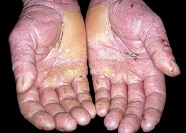The skin plays a very important role as a barrier to chemicals and other contaminants entering the body. Skin disorders may disrupt this barrier function.
Occupational skin disease is a skin disorder wholly or partially caused by a person’s work activity. It’s important to remember that skin diseases can also have non-occupational and genetic causes.
What causes occupational skin diseases?
Occupational skin diseases are caused by direct contact with one or more hazardous substances. The skin can come into contact with substances through:
- immersion
- contact with contaminated tools or surfaces, for example a workbench, tools or clothing
- splashing
- the substance landing on the skin
Occupational skin disorders include:
- contact dermatitis or eczema
- contact urticaria
- acne and folliculitis
- pigmentation changes
- skin cancer
- skin infections
Most occupational skin diseases are confined to the hands and forearms, since they are the parts of the body most often in contact with hazardous agents. The most common skin condition is contact dermatitis (also known as contact eczema). Dermatitis is caused by an inflammation of the skin. Symptoms include redness, dryness, itching, swelling, cracking, blistering, flaking and bleeding.
There are two types of contact dermatitis: irritant dermatitis and allergic dermatitis. These have the same appearance but different causes.
- Irritant dermatitis can be caused by a physical or chemical agent that damages the cells. Irritant dermatitis makes the skin more vulnerable to other hazards such as bacteria and chemicals. When there’s no more contact with what’s causing the irritation, the condition stops.
- Allergic dermatitis is caused by exposure to an allergen or sensitiser, normally a hazardous substance. When the sufferer’s immune system reacts to it, they become sensitised. Once sensitised, the problem is usually lifelong and any further exposure will lead to an attack.
Both irritant and allergic dermatitis can be present together and it’s not uncommon for allergic dermatitis to develop following irritant dermatitis. Causes of irritant dermatitis include cleaning products, organic solvents, metalworking fluids, cement and other chemicals, some plants and shrubs, and water.
Although we need water to wash our hands, too much exposure to water can cause irritant dermatitis. This is particularly important in wet work. Those involved in wet work include hairdressers, workers in the food industry and people who work with metalworking fluids.
Allergic contact dermatitis can be caused by allergens such as cement, metals (eg nickel and chromium) and resins. Latex is a common cause of allergic dermatitis. It’s commonly found in the healthcare industry, where latex gloves are worn routinely.
Common risk factors for dermatitis are atopy, wet work and the use of gloves. Although gloves can provide workers with protection, they can also present a risk. Gloves must be appropriate to the task being carried out and be used properly. Using damaged gloves can give a false sense of security. Impervious gloves form a non-permeable barrier that may result in the build up of sweat, which means the wearer is effectively carrying out wet work.
- Contact urticaria is a skin condition characterised by redness (erythema) and swellings. The swellings appear where the hazardous substance has come into contact with the skin. Swellings normally occur within an hour of exposure and disappear after 24 hours. Latex is a common cause of the condition.
- Acne is caused by a blockage and inflammation of the glands in the skin. It can be caused by exposure to oil, halogenated aromatic hydrocarbons and coal tar. It can also be caused by long term contact with oily clothes.
- Folliculitis is an inflammation of the hair follicles. This condition is common in people in the metal industry who are exposed to mineral and soluble oils.
- Pigmentary disorders include depigmentation (a loss of skin colour) and hyperpigmentation (an accumulation of skin colour). Depigmentation can be caused by chemicals such as hydroquinine, phenol (and its derivatives), arsenic and mercury compounds. It can also be caused by ionising and ultraviolet radiation, as well as thermal or physical trauma. Hyperpigmentation can be caused by mineral oils, halogenated hydrocarbons, arsenic and various pharmaceutical agents.
- Skin cancer can be caused by ultraviolet light (either sunlight or artificial), ionising radiation, polycyclic aromatic hydrocarbons, tar and tar products.
- Occupational skin infections are often caused by contact with animals or plants. Visit the Haz-Map webpage for information on jobs associated with occupational skin infections.
During the last few years, the most common agents cited by dermatologists and occupational physicians as causes of skin disease were “soaps and cleaners”, “wet work”, and “rubber chemicals and materials”.
Work-related dermatitis is very common and affects people in many industries. These include:
- agriculture/horticulture
- catering and food processing
- chemicals
- construction
- engineering
- hairdressing
- health and social care
- mining and quarrying
- offshore
- printing
- rubber.
Cases of diagnosed occupational dermatitis still remain a Reportable health condition for the Reporting of Injuries, Diseases and Dangerous Occurrence Regulations 2013 (RIDDOR13). Call us for practical advice on identifying and managing these risks in the workplace.











